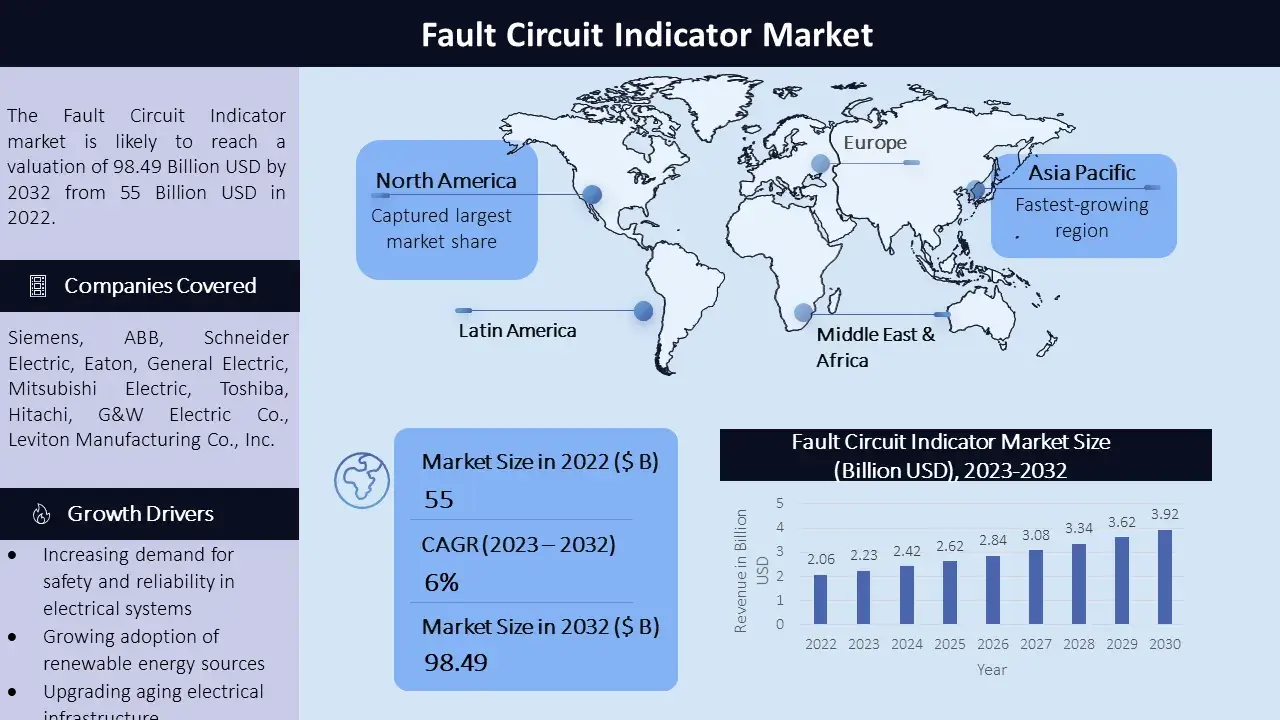Fault Circuit Indicator Market - Global Size, Share, Trends, Growth and Forecast Year ( 2023 – 2032 )
Fault Circuit Indicator Definition and Overview:
A fault circuit indicator (FCI) is a device that detects when there is a fault or the condition is abnormal of an electrical circuit. It is usually used in the distribution systems of electrical mainly to have protection against the damage caused by short circuits, over currents and other faulty conditions.
There are various types of fault circuit indicators which are available in the market that includes residual current device (RCD), ground fault circuit interrupter (GFCI), and overcurrent protective device (OCPD). These devices are used in a number of applications, which includes residential, commercial, and industrial.
Fault Circuit Indicator Market Size and Share:
The market size for fault circuit indicator market was USD 55 billion in the year 2022. It is expected that the market size for fault circuit indicators will increase to approximately USD 98.49 billion by 2032 as the market for fault circuit indicator is continuously growing at a compound annual growth rate (CAGR) of 6% during the forecast period as predicted.
The worldwide fault circuit indicator market is expected to grow significantly in the upcoming years because of the increase in demand for reliable and efficient electrical systems in different end-user industries, which includes utilities, oil and gas, mining, and manufacturing.
The market of fault circuit indicator is highly competitive in nature, with a large number of key players that are offering a wide range of products to the consumers. There are various key players in the market which includes Siemens, ABB, Schneider Electric, Eaton, and General Electric.
There are several factors driving the growth of the fault circuit indicator market which includes the increasing demand for safety and reliability in electrical systems, the growing adoption of renewable energy sources, and the increasing need to upgrade aging electrical infrastructure.
|
Fault Circuit Indicator Market Report Scope |
|
|
Base Year Market Size |
2022 USD 55 billion
|
|
Forecast Year Market Size
|
2032 USD 98.49 billion |
|
CAGR Value
|
6% from 2023 to 2032 |
|
Segmentation
|
|
|
Challenges
|
|
|
Growth Drivers
|
|
Fault Circuit Indicator Market Key Drivers:
There are various key drivers which led to the growth of fault circuit indicator market which are as follows:
- Increasing demand for safety and reliability in electrical systems:
Fault circuit indicators help to ensure the safety and reliability operations of electrical systems by detecting and indicating the faulty conditions of the circuit, which further helps in preventing the damage and downtime. The increase in demand for safety and reliability directly increase the demand for fault circuit indicators in the market.
- Growing adoption of renewable energy sources: The increase in the adoption of renewable energy resources which includes solar and wind power is directly proportionate to the rising demand for fault circuit indicators in the market these systems require reliable protection against faulty conditions.
- Upgrading aging electrical infrastructure: A number of countries have a very old electrical infrastructure which is in need of up gradation. The replacement of these out-dated and old electrical systems with modern and fault protected systems is expected to increase the demand for fault circuit indicators in the market.
- Stringent government regulations: The governments around the world are implementing strict rules and regulations to ensure the safety and reliability of the electrical systems. This is expected to increase the demand for fault circuit indicators as they help and ensure to meet these rules and regulatory requirements by the government.
- Increasing construction and industrial activities: The growing of the construction and industrial sectors around the globe due to various advancements taking place is expected to increase the demand for fault circuit indicators as these industries also rely on electrical systems for their operations.
Fault Circuit Indicator Market Challenges:
The fault circuit indicator market faces a lot of challenges in the market. These challenges are listed below:
- High upfront costs: The initial cost of installing fault circuit indicators is actually very high, which can be a barrier for some end-user industries as the high cost, if incurred, increase the demand for goods which further reduced productivity and hence this high cost has a negative impact on the fault circuit indicator market.
- Limited awareness: The literacy ratio of several countries is still very low and hence most of the end users are unaware of the fact that these fault circuit indicators benefit their electrical systems. This lack of information to the people creates hinder in the growth of fault circuit indicator market.
- Technical issues: The technical issues, such as false tripping, are very common and unpredicted factor that can happen anytime and this further impacts the market for fault circuit indicator market as it reduces efficiency and increases the downtime.
- Competition from other protective devices: The market for fault circuit indicators face a lot of competition from other protective devices, which includes circuit breakers and fuses, that directly impact the growth of fault circuit indicator market.
- Limited adoption in developing countries: The adoption of theses fault circuit indicators is also limited in various developing countries because of the higher cost of installation and lack of awareness about the benefits of these fault circuit indicators.
Fault Circuit Indicator Market Regional Synopsis:
The worldwide fault circuit indicator market is expected to have a significant growth in the upcoming years, with the Asia-Pacific region to have the largest market share in the fault circuit indicator market. This is because of the increase in demand for electricity in the region, together with the growing adoption of renewable energy sources and the need to upgrade aging electrical infrastructure.
The North American and European regions are also expected to have a significant growth, because of the increase in demand for safety and reliability in electrical systems and the implementation of strict government rules and regulations. Japan is expected to be a key market for fault circuit indicators (FCIs) because of the country's focus on safety and reliability in electrical systems. The increase in the adoption of renewable energy sources, which includes solar and wind power, is also expected to increase the demand for FCIs in Japan. The key players in the Japanese FCI market include Mitsubishi Electric, Toshiba, and Hitachi. These companies offer a variety of products, which includes residual current devices (RCDs), ground fault circuit interrupters (GFCIs), and overcurrent protective devices (OCPDs).
The Latin American and Middle Eastern & African are the regions which are expected to have a moderate growth because of the limited adoption of fault circuit indicators in these regions. However, the market in these regions is expected to have growth in the upcoming years because of the increasing construction and industrial activities in the region.
Fault Circuit Indicator Market Segmentation:
- By type: Residual current device (RCD), Ground fault circuit interrupter (GFCI), Overcurrent protective device (OCPD).
- By applications: Residential, Commercial, and Industrial.
- By geography: North America, Europe, Asia-Pacific, Latin America, and Middle East & Africa.

Fault Circuit Indicator Market Key Players:
- Siemens
- ABB
- Schneider Electric
- Eaton
- General Electric
- Mitsubishi Electric
- Toshiba
- Hitachi
- G&W Electric Co.
- Leviton Manufacturing Co., Inc.
- Others

Need Customized Report for Your Business ?
Utilize the Power of Customized Research Aligned with Your Business Goals
Request for Customized Report- Quick Contact -
- ISO Certified Logo -

















